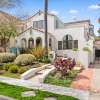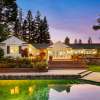Hayward Park has been mostly untouched by development over the years, and still maintains its original charm and historic feel. Hayward Park was the name of the 800-acre estate owned by Alvinza Hayward, who has been called “California’s first millionaire.” The estate, which boasted a spectacular residence, included a lake, race track and deer park. The property was converted into the Peninsula Hotel after Hayward's death in 1904. It burned in a spectacular 1920 fire.
Unlike some other estate owners, Hayward saw economic promise in helping San Mateo to develop. He dabbled in civic improvements and local politics to help the community grow, and much of what he did was very important to the future of the city. Perhaps his greatest achievement was the creation of the city’s first permanent water supply.
Some time before 1870, he had bought property up San Mateo Creek, between Byrnes’ Store and Crystal Springs for the purpose of building a watershed. By 1870 he had built a dam to form the city’s first municipal reservoir, and by that summer, pipes had been laid to the community, providing homes within San Mateo with a constant flow of fresh water. Later, when the Spring Valley Water Company bought up his water rights, Hayward made it a condition of the sale that the Company had to furnish 100,000 gallons of water daily (without compensation), to the San Mateo system in perpetuity.
Between 1922 - 1925 on the site of the old Hayward Mansion, the Glazenwood Tract was developed. This became San Mateo's first "restricted" real estate development: persons of certain races, national origins or religions were not welcome. Racial prejudice was a very real factor during the 1920s and 1930s. A public membership drive for the Ku Klux Klan was launched in 1924, when the San Mateo Times carried a front page headline: "Ku Klux Klan Seeks Members in San Mateo."
In general, the African-American community mixed well in communities that had been set aside for ethnic diversity. Most were laborers, but there were also entrepreneurs within the community. None became more famous than Noah Williams.
Williams came from a family of famous cooks; his father had been chef for the Rock Island Line and also Noah Junior became a railroad chef. About 1920, Williams moved to San Mateo and opened Noah's Cafeteria at 139 South B Street. People came from all over the Peninsula and lined up on the street for his famous baked ham and fried chicken. Three years later he moved from B Street to Third Avenue and renamed the restaurant Noah's Ark. The Depression killed off this landmark restaurant in 1931. Noah opened another retaurant on El Camimo Real, but it never acjhieved the fame and popularity of Noah's Ark. Osteria Coppa Restaurant now stands at the site of the original Noah's Ark.
Hayward had moved to California during the Gold Rush of 1850. He acquired a one-third interest in the Utica/Selkirk mine near Angels Camp and in 1901 more than $7 M in gold was removed from Utica. He was also a director of the Bank of California, and in 1870 was one of the original investors in the San Francisco City Gas Company, which would eventually become the Pacific Gas and Electric Company.
The neighborhood is within walking distance to downtown San Mateo and is anchored by Central Park to the north, San Mateo’s largest and most popular public park. Most homes are one level bungalow and Craftsman style and range from 1,110 – 1,600 square feet, and prices range from $700,000 up to around $1,000,000, with the sweet spot being in the $800,000 - $925,000 range, Hayward Park is east of El Camino, and is bordered by the 92 Freeway to its south.
If Hayward Park sounds like home sweet home to you, click here to check our current listings, or contact us by calling 650-720-5483. If you’d rather email, click here. Just give us some information and we will help you find the home of your dreams.

This article is copyrighted by Raziel Ungar and may not be reproduced or copied without express written permission.
=








